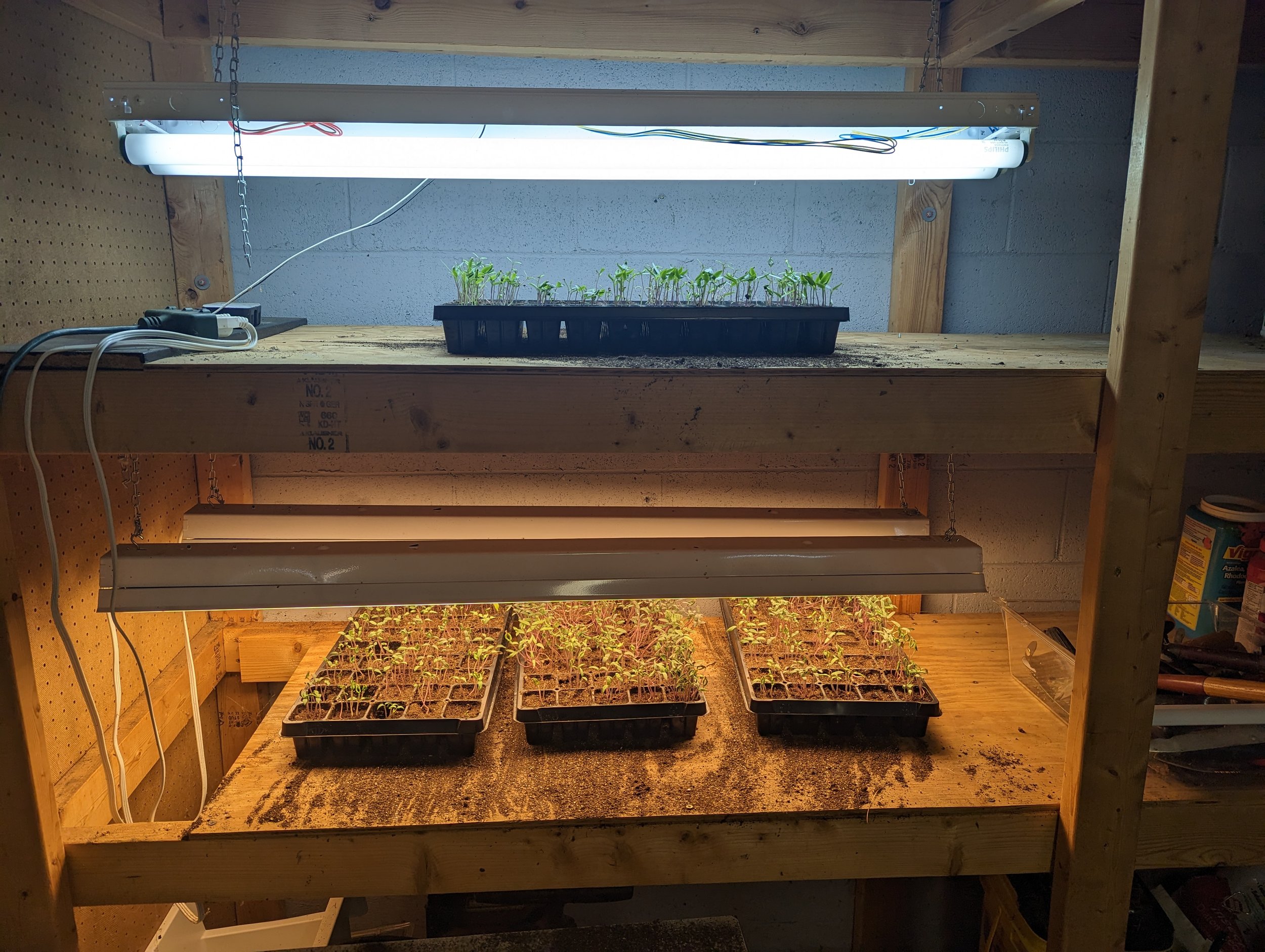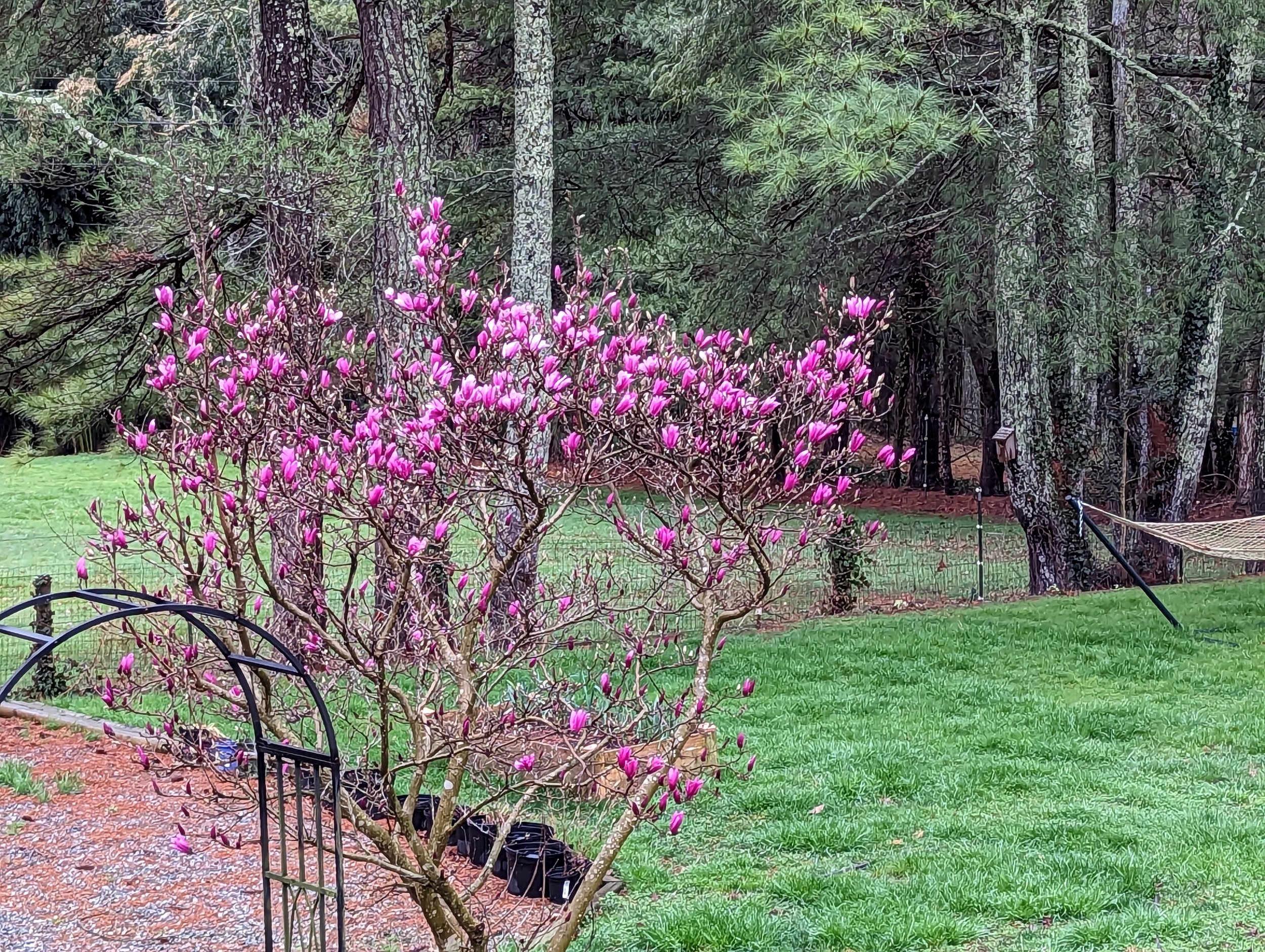In the last few blogs I talked about my first plantings - greens, flowers (especially hibiscus), and older tomatoes - along with some peppers and eggplants.
On March 7, I did a marathon planting session - three flats of 50 cells, each containing a different variety. Today is day 3 and germination is happening. My older tomato seed flat is out sunning itself on the side deck. I just finished transplanting the hibiscus, and the greens are proceeding well.
Here is what got planted on March 7.
Flat 1 - all Dwarf Tomato Project released varieties from Victory Seeds unless otherwise noted. For the most part, 5 seeds of each were planted.
Adelaide Festival, Banksia Queen, BrandyFred, Chocolate Lightning, Coorong Pink, Dwarf Awesome, Dwarf Beauty King, Dwarf Big Valentine, Dwarf Black Angus, Dwarf Blazing Beauty, Dwarf Choemato, Dwarf Elsie’s Fancy, Dwarf Emerald Giant, Dwarf Firebird Sweet, Dwarf Gloria’s Treat, Dwarf Golden Tipsy, Dwarf Goldfinch, Dwarf Grinch, Dwarf Hannah’s Prize, Dwarf Idaho Gem, Dwarf Kodiak King, Dwarf Mahogany, Dwarf Mr. Snow, Dwarf Orange Cream, Dwarf Parfait, Dwarf Confetti, Dwarf Peppermint Stripes, Dwarf Perfect Harmony, Dwarf Pink Livija, Dwarf Purple Heart (from Fruition), Dwarf Purple Heart (Victory), Dwarf Russian Swirl, Dwarf Sarah’s Red, Dwarf Saucy Mary, Dwarf Sonrojo Monster, Dwarf Snakebite, Dwarf Suz’s Beauty, Dwarf Sweet Sue, Dwarf Tanager, Dwarf Walter’s Fancy, Dwarf Wild Fred, Dwarf Wild Spudleaf, Dwarf Zoe’s Sweet, Loxton Lad, Loxton Lass, Lucky Swirl (Fruition), Lucky Swirl (Victory), Maralinga, Rosella Crimson, Rosella Purple (Southern Exposure Seed XC).
So, what’s the story with all of these released dwarfs? I’ve been wanting to do a test plant of our releases to see what people are purchasing/growing, vs what we wanted to release as a project. It will also be great for seed saving and photodocumenting. I hope to grow these at the Veterans Healing Farm greenhouse. Many of my favorite larger fruited dwarfs are in that list. Such fun!
Flat 2 - here are all indeterminate varieties. Many of these are more densely planted so I have extras for locally interested folks.
Cherokee Purple, Cherokee Chocolate, Cherokee Green, Mexico Midget, Sun Gold, Casey’s Pure Yellow, Lillian’s Yellow Heirloom, Lucky Cross, Large Lucky Red, Estler’s Mortgage Lifter, Captain Lucky, Purple Dog Creek, Price’s Purple, Potato Leaf Yellow, Big Sandy, Gallo Plum, Dorothy’s Green, World War II, Monticello Mystery, Polish, McCutcheon, Bisignano #2, Brandywine, Dester, Stump of the World, Ferris Wheel, Cancelmo Family Heirloom, Eva Purple Ball, Red Brandywine, Giant Syrian, Hege’s German Pink, Hugh’s, Indian Stripe, JD Special C-Tex, Yellow Brandywine, Pink Princess, Weber, Abraham Brown, Nepal, Green Giant, Tundra, Taiga, Fritsche Family, Stocky’s, Egg Yolk, Anna Russian, Coyote, TBT, Ruthje and Bing.
This is quite a grab bag. Some of my long-time-grown, real favorites are in this group. There are a few former favorites I am returning to for the first time in many years. I am also growing a slew that need fresh saved seed. There are also some that have been recently sent to me by friends. Some of these will be in my yard, and most will be at the Veterans Healing Farm greenhouse.
Flat 3 - this is a real slew of all sorts of things, some indeterminate and some dwarf. This is also the third flat I planted, late at night, and there is an error somewhere with variety vs cell that I will have to solve once the seedlings emerge. Here goes…
Four F3 selections from Cherokee Purple X Lillian’s Yellow Heirloom (one of which I named Lillian’s Rose), two F3 selections from Little Lucky X Blue’s Bling, one F3 selection from Polish X Blue’s Bling, a first look at F2 from crosses I made a few years ago - Ferris Wheel X Striped Sweetheart, Don’s Double Delight X Cancelmo Family Heirloom, and Cherokee Green X Caitlin’s Lucky Stripe; Earl, seven from the Fairy Tale series - Snack, Shine, Garnet, Elf, Fairy Tale, Gold and Angel; an F3 selection from Cherokee Chocolate X Stump of the World, Cherokee Green X Earl F1 hybrid, an F3 selection from Green Giant X Cancelmo Family Heirloom, Abraham Lincoln from the USDA seed stock, Lillian’s Yellow X Zena’s Gift F1, Kosovo, Marlowe Charleston, the Peregrine Farm selection of Cherokee Purple, Andrew Rahart’s Jumbo Red, Aker’s West Virginia, the chartreuse leaf version of Dwarf Jade Beauty, a pink fruited gold striped F3 selection from Lillian’s Yellow Heirloom X Dwarf Speckled Heart, Dwarf Langston, another set of Victory released dwarfs - Uluru Ochre, Wherokowhai, Rosella Purple, Summertime Green, Summer Sunrise, Sweet Scarlet Dwarf, TastyWine, Willa’s Cariboo, Wilpena; Rosella Crimson, Dwarf Gloria’s Treat, Dwarf Emerald Giant, Dwarf Eagle Smiley, Dwarf Irma’s Highland, Dwarf Phyl’s Ivory Beauty, Dwarf Harmonic Convergence, Dwarf Shimmering Beauty, Dwarf Chilli Chick’s Wonder, Dwarf Sara’s Olalla Emerald, and Dwarf Swirly Heart.
I can’t even start to ponder where each of the above will go, but a fair number will be grown in my yard, particularly some of the more interesting mysteries. Once I confirm which varieties are growing where, and start to form plans on what I will be growing where, a future blog will lay it all out.



























